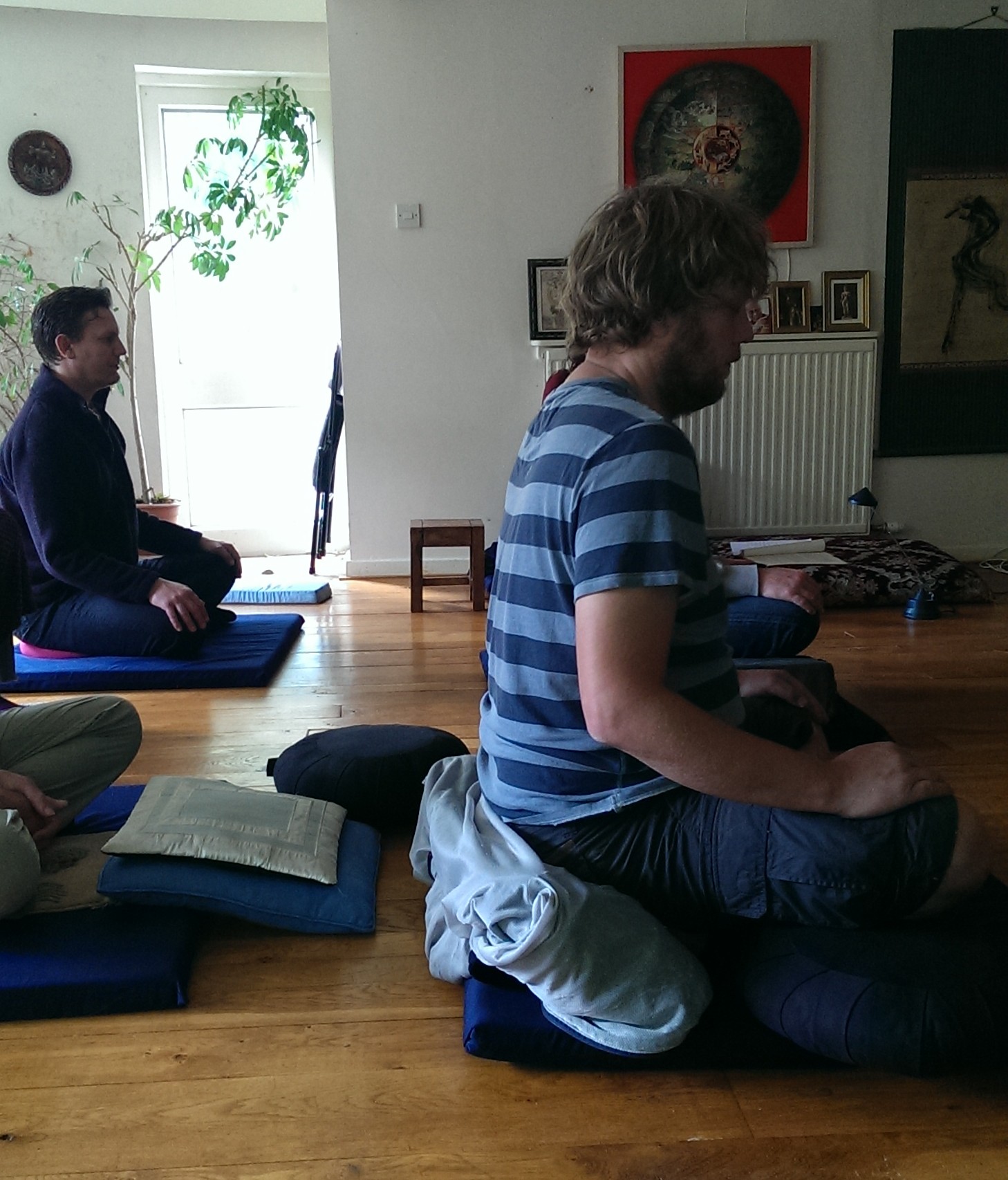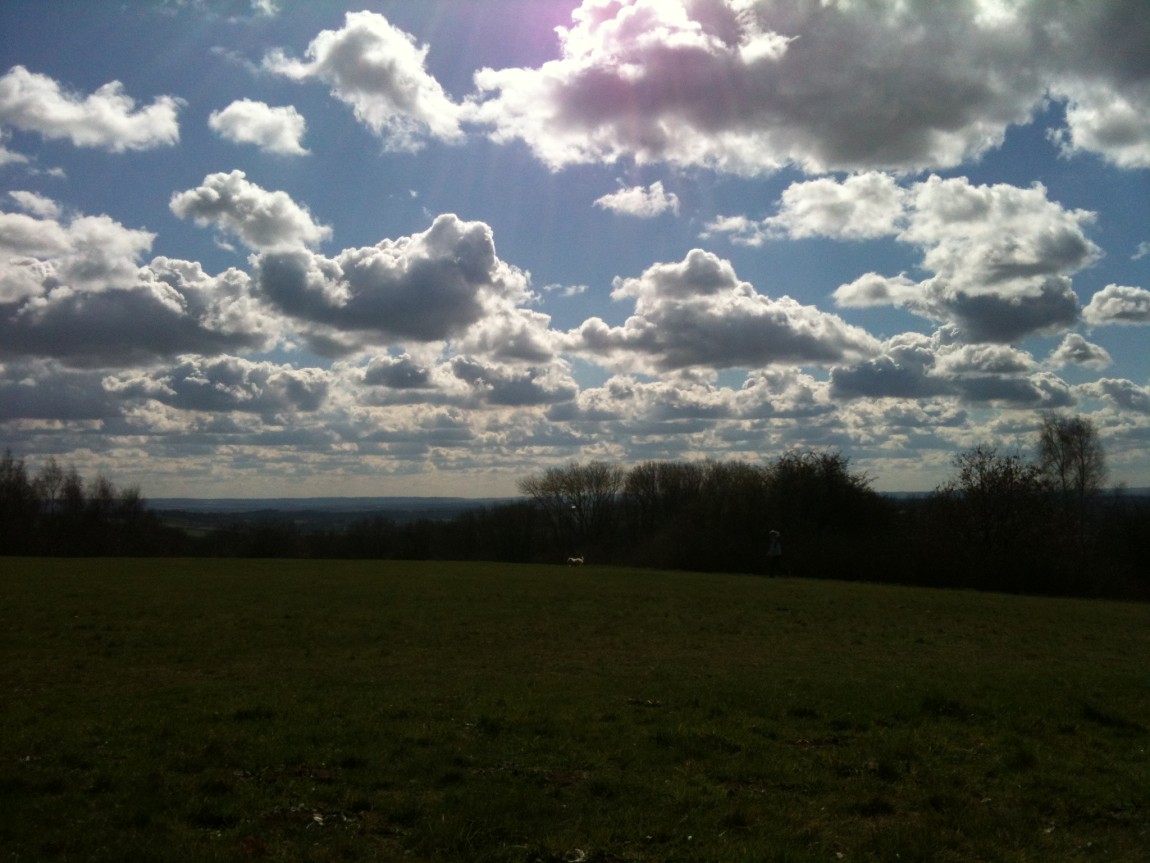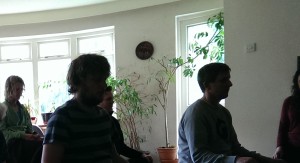What follows is the traditional instruction to the most basic and yet profound practice of formless meditation. There are three aspects to the practice. The body aspect or physical posture, speech aspect (breath) and mind aspect. Each will be dealt with in turn.
BODY
Take a comfortable, alert, relaxed position
Sit cross-legged on a cushion or kneel on a meditation stool, or use a chair if that is most comfortable (hard-backed like a kitchen chair). Choose a cushion or chair that suits you
Relax your shoulders, but stay upright enough to feel yourself breathing easily and fully
Rest your hands on your thighs, palms down, leaving your body open and relaxed
Leave your eyes neither shut nor fully open, allowing them to rest on the floor three or four feet ahead of you
If you really start to hurt, stay with it long enough to get the flavour of what is going on, then move gently to a more comfortable position

SPEECH (breath)
Follow the natural rhythm of your breath whether fast or slow, do not try to change it at all. Let the mind rest on the rhythm of the breath and gradually let go into space in a natural way
Focus on a sense of well-being and space, an opening out to whatever experience arises, giving it space, letting it be, resting in that vast space of awareness
As you breathe out, let go into the sensation of space, vastness and openness. There is movement associated with the outbreath and then a still, relaxed melting into space. Let the inbreath look after itself
Notice the rhythm of rest and focus. The ebb and flow of the practice is the alternation of the sense of movement of the outbreath or of the insight into space, with the sense of peace between the outbreaths
To begin with, it is a good discipline to keep making yourself return to the rhythm of the outbreath. This gives some sort of discipline to keep your mind from simply following its usual track
If you get tense, or feel short of breath, just tell yourself to stop meditating for a few moments. You don’t need to get up or change position
MIND
Feel confidence in the Openness Clarity Sensitivity of being Open to the sense of the vastness of your true nature

Rest in the feeling of your absolute right to be here, now, doing this. Don’t try to stop thinking, you won’t do that and it is not what this is about
Welcome whatever comes, thoughts, feelings, emotions, comfortable or not, as guests
See them, taste their flavour, then let them pass on as you return to the outbreath
If the idea arises that they are an interruption to your meditation, just see that as another guest, and let it go
Commentary
It is important to practise regularly and specifically put aside some time each day to do the practice. There is no particular time of day which is recommended for doing the meditation, you have to work out something which suits your particular situation. It is good to do one hour of formless practice each day, and in the beginning you shouldn’t do more than that. You can start off by doing twenty minutes or half an hour every day, to give yourself the chance to properly connect with the practice. It is much better to do some meditation every day, rather than a large amount at the weekend for example, although you could do a little more when you have some extra time. Tibetans value what they call stability, which is the idea of persistence. You might not feel you are a particularly good meditator, but if you are persistent and keep at it, you are already showing the signs of being a good practitioner. The most important thing about the practice is consistency, making a continual effort at a level which is suitable for you.
When we get into the practice of formless meditation and become better able to relate to our experiences, we may indeed become calmer and more stable. But from a Buddhist perspective that is just a spin-off.  The purpose of this meditation is simply to connect with a feeling of spaciousness and vastness so that some kind of insight or vision associated with discovering the nature of your experience can arise through the development of awareness. When you discover something of the nature of your mind, you also see something of the nature of the world and the nature of others.
The purpose of this meditation is simply to connect with a feeling of spaciousness and vastness so that some kind of insight or vision associated with discovering the nature of your experience can arise through the development of awareness. When you discover something of the nature of your mind, you also see something of the nature of the world and the nature of others.
Although this is a meditation for beginners. it is not just a beginner’s meditation, because it carries with it implications relating to the whole of enlightenment. At the highest point of Buddhism, the stage of Maha Ati the Great Perfection, the practice is remarkably similar in some ways. At that stage you are no longer a practitioner of the meditation, but as Trungpa Rinpoche said, “You become the meditation”. Your mind is just awareness and openness.
Adapted from Openness Clarity Sensitivity by Rigdzin Shikpo.
New to meditation?
If this is the first time you have meditated, then please know that meditation, like any powerful tool, takes time and guidance to master. There are a number of pitfalls along the path of training. If you intend to meditate regularly, it is advised that you find a qualified buddhist meditation instructor to guide you.
